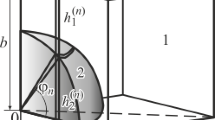Summary
General bounds on the moduli of isotropic composites of two isotropic and purely elastic phases have been obtained byHill, Hashin andShtriknan, andWalpole. It may be shown that, in most cases of importance, these are best possible bounds for arbitrary phase geometry. Bounds can also be found for the real and imaginary parts of the complex moduli of composites with viscoelastic phases. In all cases, however, the bounds are wide when the moduli of the phases are very different, so phase geometry must be taken into account in order to obtain results of practical value. Calculations of rigidity are therefore made for incompressible composites in which one phase forms spherical inclusions in the other. An exact formula is obtained for a case in which the size distribution of these inclusions is very wide, and approximate formulae for two cases of inclusions of uniform size (nearest-neighbour distance being a maximum in the one and a minimum in the other). These have been applied in a study of the frequency variation of the real part of the rigidity and the loss tangent of a composite of equal volumes of two viscoelastic phases, each having sharp loss-tangent peaks at different frequencies. The effect of variations in the spatial distribution and size distribution of the inclusions can be inferred from the results, as well as the effect of phase inversion.
Zusammenfassung
Allgemeine Schranken für die Moduln isotroper Stoffsysteme, bestehend aus zwei isotropen, rein elastischen Phasen, wurden vonHill, Hashin undShtrikman, sowieWalpole angegeben. Es kann gezeigt werden, daß in den meisten wichtigen Fällen diese die besten möglichen Schranken darstellen, die für eine willkürliche Phasengeometrie erhalten werden können. Ebenfalls können Schranken für Real- und Imaginärteil der komplexen Moduln von zusammengesetzten viskoelastischen Phasen gewonnen werden. Indessen liegen diese Schranken weit auseinander, wenn die beiden Phasen sehr verschiedene Moduln haben. Daher muß in solchen Fällen die Phasengeometrie in die Betrachtung einbezogen werden, wenn man Ergebnisse von praktischer Bedeutung erhalten will. Es wird hier die Berechnung der Steifigkeit für inkompressible zusammengesetzte Stoffe durchgeführt, bei denen die eine Phase in Form von kugelförmigen Inklusionen in der andern vorliegt. Exakte Formeln werden für den Fall erhalten, daß die Größenverteilung der Inklusionen sehr weit ist, sowie Näherungsformeln für zwei Fälle von Inklusionen mit gleicher Größe — wobei der kleinste Abstand zwischen zwei Teilchen im ersten Fall maximal, im zweiten dagegen minimal gewählt wird. Diese Ergebnisse werden zur Untersuchung der Frequenzvariation des Realteils der Steifigkeit und der Dämpfung verwendet für eine Zusammensetzung gleicher Volumenanteile zweier viskoelastischer Phasen, die bei verschiedenen Frequenzen jeweils scharfe Dämpfungsmaxima besitzen. Die Auswirkung der Variation sowohl der räumlichen als auch der Größenverteilung der Inklusionen ebenso wie diejenige einer Phasenumkehr kann aus den Ergebnissen abgeleitet werden.
Similar content being viewed by others
References
Brinkman, H. C., J. Chem. Phys.20, 571–573 (1952).
Eshelby, J. D., Progress in Solid Mechanics (ed. byI. N. Sneddon and R. Hill), Vol. 2, Chap. III (Amsterdam 1961).
Hashin, Z., J. Appl. Mech.29, 143–150 (1962).
Hashin, Z. andS. Shtrikman, J. Mech. Phys. Solids11, 127–140 (1963).
Hill, R., J. Mech. Phys. Solids11, 357–372 (1963).
Roscoe, R., Brit. J. Appl. Phys.3, 267–269 (1952); J. Mech. Phys. Solids20, 91–99 (1972).
Walpole, L. J., J. Mech. Phys. Solids14, 151–162 (1966); Q. J. Mech. & Appl. Maths.25, 153–160 (1972).
Author information
Authors and Affiliations
Additional information
With 4 figures
Rights and permissions
About this article
Cite this article
Roscoe, R. Isotropic composites with elastic or viscoelastic phases: General bounds for the moduli and solutions for special geometries. Rheol Acta 12, 404–411 (1973). https://doi.org/10.1007/BF01502992
Received:
Issue Date:
DOI: https://doi.org/10.1007/BF01502992




